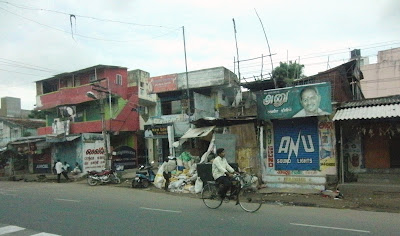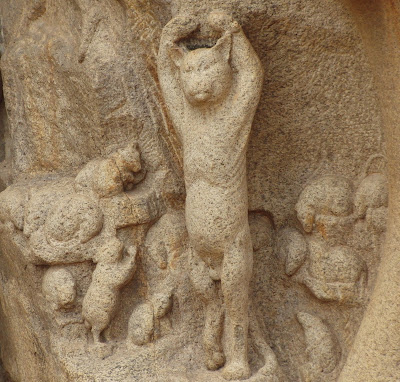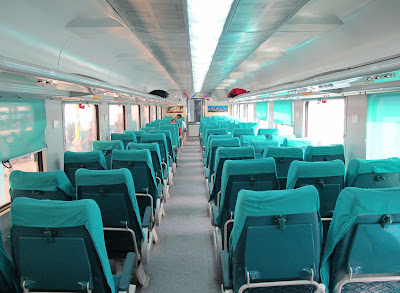I’m not sure what to think about Singapore. We docked where cruise ships do and emerged from security into the fringes of a monstrously large, crowded, overwhelming mall. Perhaps it is the stark contrast of its fluorescent lights, gleaming hard surfaces, very upscale stores and enormous crowds of vacationing Asians with the grime, smells and pollution of Chennai that gave it a surreal feel. Singapore seems to function as the Disney World of Asia and that is an odd world to enter just three days out of India.
The mall, Vivocity, was very confusing and we literally got lost one evening and began to worry that we’d be locked in the mall since we couldn’t get our bearings. At one point, we went into what appeared to be a Wal-Mart type store and proceeded to the grocery which turned out to be two floors down into the basement. We made our way through the grocery section and exited out the back to find ourselves in another enormous wing of the mall. The one positive was that we found the ice cream we were interested in and got to try durian ice cream too. Durians are fruit found in SE Asia that smell to high-heaven, but revered for their flavor by many. In Singapore, it is illegal to eat durian in public or a hotel or to bring it on public transportation. This meant that if we wanted to try it, we’d need to go to “The Four Seasons Durian Café”. We were not successful in our attempts to find the café, so we were happy to be able to try the ice cream. It smelled a bit “skunky” and initially tasted a tad garlicky (like the flavor you get if you slice fruit on a cutting board upon which you’ve recently sliced garlic) before that sulfur-based flavor subsided and tasted fruity. I still hope to be able to try the fruit in Vietnam.
Most everyone knows that Singapore has a very strict system of laws and there was evidence of that most everywhere we went. I think what surprised me about this was the friendly tone of the reminders about what was and was not legal. There were posters reminding us not to litter, not to spit, not to eat or drink on the train and even looping commercials about how to board the train on closed circuit TV playing on the rapid transit system. They addressed the system that should be adhered to for boarding a train – basically, one should Q to the side to allow passengers to disembark first.
There were signs – mostly friendly looking cartoons – letting people know the fines for particular offenses. The tourist trade must be making a mint off of the t-shirts sold all over that play on this aspect of Singapore law. There are t-shirts that list all the offenses and monetary fines (it isn’t so funny to list out capital punishment), those that say “Singapore is a FINE city”, etc. At least the government lets folks make light of it. I will say that Singapore is safe and clean, but many of us spent our time constantly analyzing whether or not what we were doing was illegal. I fed a cat some meat left over from our cooking class and I was probably doing something illegal. We jaywalked in Chinatown because everyone else was, but I was waiting for the big fine at any point.
On the first day we enjoyed a dim sum lunch in Chinatown. The thing about Singapore is that it is a melting pot of Asian cultures and it seemed that nothing was strictly Chinese, Indian or Malaysian, etc. For example, a chili sauce served with the dim sum was something I’d never encountered with that type of meal. It was similar to a mixture of Korean and SE Asian sauces I’ve had. In the grocery, all food comes from elsewhere. It was a bit like shopping in a grocery in a big city that caters to many Asian immigrants. It was odder though, because there were also German, American, Italian, etc. products. One interesting find were grapes from the US. WE don’t even get those at home – ours are from Chile!
I love the packaging in Asia and found the description of this snack food fascinating:
I have always said that an excellent dose of delicious food adds onions and that crispy crispy good flavor is a must!
After abandoning our efforts to sample some durian, we made our way back to Chinatown for a dinner of giant prawn noodles from a stall on Food Street. Again, it was a bit of Asian fusion. The broth was spicy and tasted like it had some of the roasted chilies in oil paste that I make for Thai cooking, the noodles were Chinese and it came with a soy sauce/red chile garnish that itself seemed to be a fusion of Japanese or Chinese/Thai or Vietnamese. It was good except that the shrimp was very sweet. A couple of bottles of Tiger beer helped cut the heat!
On the second day in port, I participated in a Semester at Sea organized cooking class at a place called At-Sunrice Cooking Academy. While the two dishes we made were good, it took much longer than required – we only had two days and one night in Singapore - and it was very expensive at $99. We had some fun cooking but ended up with four people at our station – all things considered the group worked amazingly well together and the dishes turned out great. We made kung pao chicken that was very tasty. I wish I knew what type of dried red peppers we used. For the most part, they had excellent flavor and moderate heat. I say for the most part because every so often one was sizzling hot – the last one I ate was like this and had my eyes and nose running.
Interestingly, we marinated the chicken and then deep-fried it. It helped keep it moist and gave it great color, yet it wasn’t oily because the oil temperature was high enough to prevent that. The chef recommended cotton seed oil…not sure how available that is in the US, but it worked well. We used lots of garlic and ginger as well as ground white pepper to give it great flavor.
The other dish we prepared was fried rice with the usual suspects – diced roasted pork, diced vegetables, green onion, and egg. We also added shrimp. Both recipes were good and very easy to do at home. I do wish we’d learned some of the uniquely Singaporean food instead of Chinese. They serve chili crabs, chicken rice, and other local specialties that I can’t recall – I would’ve loved to have made one of those.
After the cooking class I met up with Greg and we went to have pizza from a wood-fired oven. It sounded good, but was just okay because I don’t believe they actually had a wood-fired oven. I had hoped to get some “pork floss” – a marinated grilled thin piece of meat (kind of like a fresh jerky). We’d had a sample in Chinatown and it was good. It was reminiscent of the flavor of Korean bulgogi. We ran out of appetite, money and time though so we were floss-less. I was also sorry we didn’t have time to eat at the Piggy Porky restaurant we spotted in Chinatown.
They Lay’s potato chips in Singapore were of the varieties found in the US. They had plain, sour cream and onion, etc. so we didn’t get any. We did, however, try some cassava chips. They were sliced ultra thin that had a very slight BBQ flavor (Greg inadvertently got them with a flavoring). They were nice and crispy, but nothing I’d seek out. Then again, I don’t ever buy potato chips at home so I guess that is not a good measure of quality.
We visited a beautiful Buddhist temple – the Buddha’s tooth temple – in Chinatown. It was beautiful and it was interesting as the monks were chanting when we went through. It had many floors with one featuring a sealed room containing what is supposed to be part of one of Buddha’s teeth and it was festooned with lots and lots of gold leaf.
It also housed the largest cloisonné prayer wheel (not sure how many cloisonné prayer wheels in the world there are, but I will verify that this was sizable).
What I enjoyed most was a small museum of the story of Buddha and a display of artifacts. I learned a good deal and got to bathe a Buddha statue which pleased me to no end for some reason. A visit to the bookstore resulted in my purchasing a lovely Way of the Buddha book of verses. Ending the day with a verse or two is a nice way to go to sleep. I find I’m intrigued with Hinduism and Buddhism and have several books on order from Amazon already.
We have one day until we hit Saigon or Ho Chi Minh City in Viet Nam. It is far too soon and I’ve spent a good part of the day in a semi-comatose state. We did too much walking in the heat and humidity on hard concrete. I need to rally for tomorrow!




































































